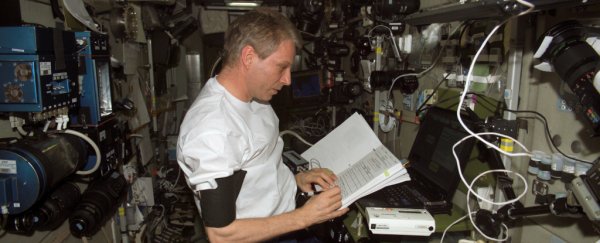Space does plenty of whacky things to astronauts' bodies, like deteriorating their muscle mass and making them on average 5 centimetres (2 inches) taller.
But scientists have uncovered another, more subtle side effect - space is totally ruining astronauts' perfect eyesight.
In fact, 80 percent of astronauts who come back from long-duration missions display symptoms of a mysterious eye condition that causes nearsightedness, Shayla Love reports for The Washington Post.
While it's a myth that all astronauts have to have natural 20/20 vision (they're allowed to have corrective laser surgery) by the time they launch, their vision does need to be flawless - so this problem could be a big issue for future human spaceflight missions, like the one hoping to get humans to Mars by the 2030s.
So what's causing all the vision problems? John Phillips, who was on board the International Space Station in 2005, was the first to notice the condition.
Throughout his time in orbit his vision suffered - although not enough to let mission control know about it - and when doctors tested him on his return to Earth, they found his vision had deteriorated from 20/20 to 20/100 during his six months in space.
Not only that, but his tests showed that his eyes had actually changed as well.
"The backs of his eyes had gotten flatter, pushing his retinas forward. He had choroidal folds, which are like stretch marks. His optic nerves were inflamed," reports Love.
NASA initially thought it was an isolated case, until they found evidence that the majority of astronauts had suffered some kind of vision problems while in space, or upon their return.
They've now called this condition 'visual impairment intercranial pressure' syndrome, or VIIP, and the leading hypothesis is it's being caused by the lack of gravity causing pressure to build up in astronauts' head.
On Earth, gravity pulls fluid towards our feet, but in space, that doesn't happen - during Scott Kelly's year in space, a two-litre bottle's worth of liquid shifted to his brain.
All of this extra fluid in in the skull could be putting pressure on the back of the eyeballs, causing them to flatten, and pushing the retinas forward to distort vision - at least that's what scientist think is happening.
The problem is that while scans have confirmed the eye-flattening part of things, the only way to monitor intercranial pressure is to perform a spinal tap or drill a hole in someone's head - both options that aren't ideal in space.
But in future, it's something that NASA might have to consider if it wants to figure out for sure what's going on, and how to solve it.
The good news is that they're already testing out options to reduce eye pressure. Astronauts are now regularly required to wear something called a Russian Chibis suit, which is a pair of giant pants that suck the air out from around a wearer's legs to simulate gravity.
The research is in the early stages and more data is needed, but John Charles, the chief scientist at NASA's Human Research Program, told The Washington Post that restoring the flow does seem to have an effect on the eye.
NASA is also working on other ways to keep astronauts strong and healthy during their time in space - including regular exercise and growing their own vegetables - so that by the time humans get to Mars, they'll be ready to take on whatever the Red Planet has to throw at them.
It turns out they might also need to pack some glasses for the mission, just in case.
